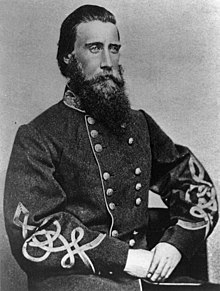
Back جون بيل هود Arabic جون بيل هود ARZ John Bell Hood Catalan John Bell Hood Danish John Bell Hood German John Bell Hood Spanish جان بل هود Persian John Bell Hood Finnish John Bell Hood French John Bell Hood Italian
John Bell Hood | |
|---|---|
 | |
| Nickname(s) | Sam[1] |
| Born | June 1, 1831 or June 29, 1831 Owingsville, Kentucky, US |
| Died | August 30, 1879 (aged 48) New Orleans, Louisiana, US |
| Buried | Metairie Cemetery, New Orleans, Louisiana, US |
| Allegiance |
|
| Service/ |
|
| Years of service |
|
| Rank |
|
| Commands held | |
| Battles/wars | |
| Alma mater | United States Military Academy |
| Signature | |
John Bell Hood (June 1[2] or June 29,[3] 1831 – August 30, 1879) was a Confederate general during the American Civil War. Hood's impetuosity led to high losses among his troops as he moved up in rank. Bruce Catton wrote that "the decision to replace Johnston with Hood was probably the single largest mistake that either government made during the war." Hood's education at the United States Military Academy led to a career as a junior officer in the infantry and cavalry of the antebellum U.S. Army in California and Texas. At the start of the Civil War, he offered his services to his adopted state of Texas. He achieved his reputation for aggressive leadership as a brigade commander in the army of Robert E. Lee during the Seven Days Battles in 1862, after which he was promoted to division command. He led a division under James Longstreet in the campaigns of 1862–63. At the Battle of Gettysburg, he was severely wounded, rendering his left arm mostly useless for the rest of his life.[4] Transferred with many of Longstreet's troops to the Western Theater, Hood led a massive assault into a gap in the Union line at the Battle of Chickamauga but was wounded again, requiring the amputation of his right leg.
Hood returned to field service during the Atlanta Campaign of 1864 and, at the age of 33, was promoted to temporary full general and command of the Army of Tennessee at the outskirts of Atlanta, making him the youngest soldier on either side of the war to be given command of an army. There, he dissipated his army in a series of unsuccessful assaults and was forced to evacuate the besieged city. Leading his men through Alabama and into Tennessee, his army was severely damaged in a massive frontal assault at the Battle of Franklin. He was decisively defeated at the Battle of Nashville by his former West Point instructor, Major General George Henry Thomas, after which he was relieved of command.
After the war, Hood moved to Louisiana and worked as a cotton broker and in the insurance business. His business was ruined by a yellow fever epidemic in New Orleans during the winter of 1878–79. He succumbed to the disease, dying just days after his wife and oldest child, leaving ten destitute orphans.
- ^ Eicher, p. 302. Bonds, p. 77, stated that there was no contemporary evidence that Hood was called "Old Woodenhead". It appears to have been an invention by some historians (such as by Edward A. Pollard, who in the Life of Jefferson Davis, referred to Hood as having "a lion's heart and a wooden head"). Woodworth, p. 271, states that after Hood's leg amputation at Chickamauga, his soldiers called him "Old Pegleg."
- ^ Eicher, p. 302; Warner, p. 142; Handbook of Texas Online.
- ^ Jones, p. 213; McMurry, p. 5; About North Georgia Archived 2008-10-11 at the Wayback Machine website; JohnBellHood.org website. June 29 is the date given on his tombstone. It, therefore, seems the more likely.
- ^ Hood, Stephen M., pp. 20–21.
© MMXXIII Rich X Search. We shall prevail. All rights reserved. Rich X Search